FUTURE PROOFING
SA’s first electric taxi is ‘a stepping stone’ for lagging EV industry
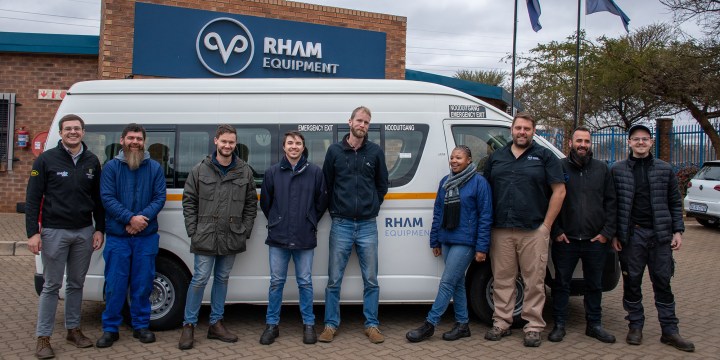
While South Africa’s electric vehicle industry lags behind many other countries, a team from Stellenbosch University wants to push the sector forward – starting with minibus taxis.
Amid the global race to electrify the transport sector – where SA seriously lags behind – it was a good day for Stellenbosch University’s Faculty of Engineering last month when they successfully test-drove SA’s first electric minibus taxi.
Their project, in partnership with Oxford University and Rham Equipment, and sponsored by the South African National Energy Development Institute (Sanedi), set out to prove that it is feasible to electrify taxis – given how they are used, and their potential impact on the grid – and that it is possible to retrofit an existing internal combustion engine (ICE), such as your normal petrol or diesel car, with an electric motor and battery.
MJ (Thinus) Booysen, the engineering professor at Stellenbosch University who supervised the project, said that along with finding ways to decarbonise the transport sector, “I’m hoping to build up the skills in the country by doing this, so that when we produce new electric vehicles, eventually, there is at least some skill set in the country. So this is for me, a stepping stone”.
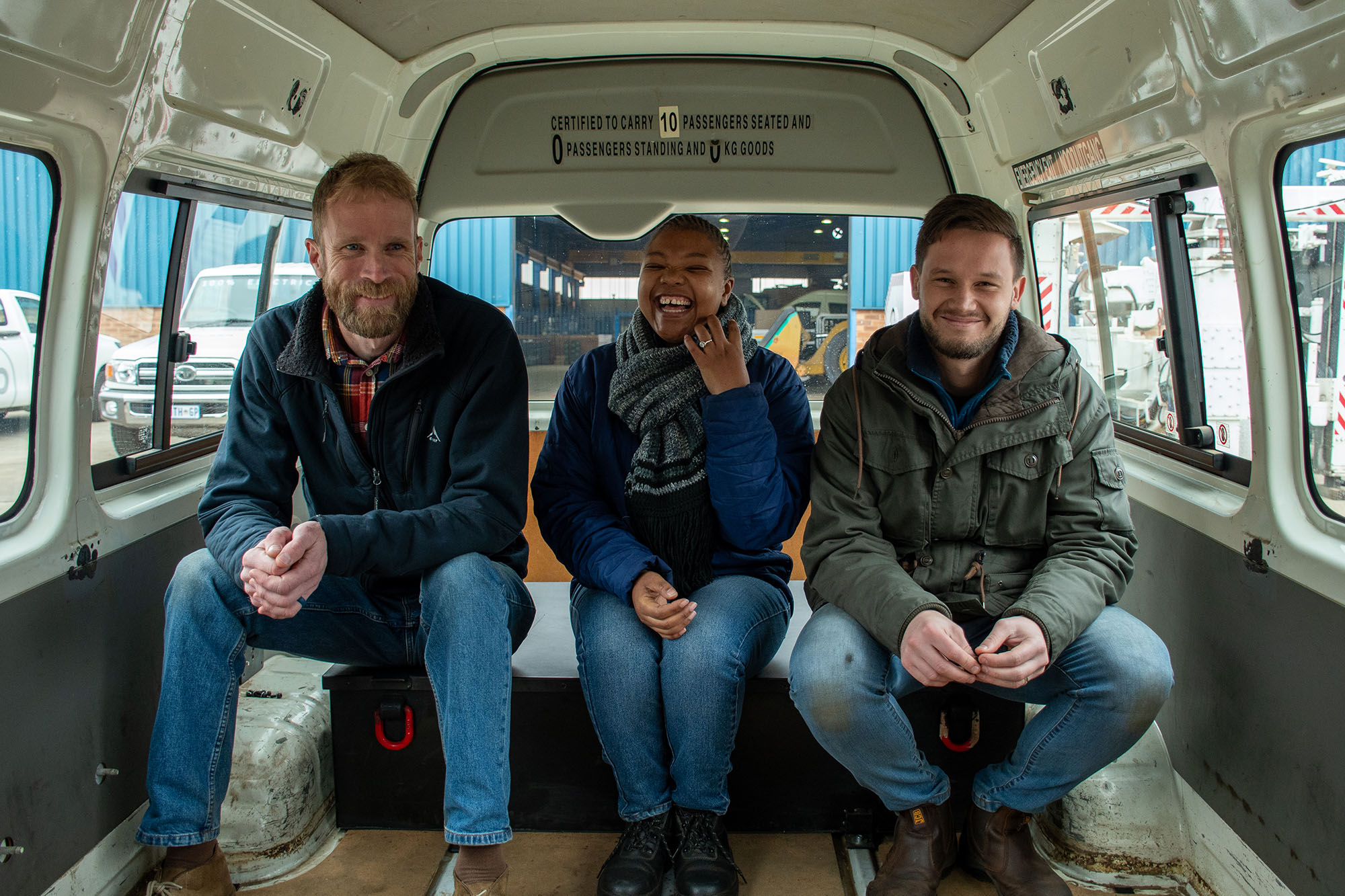
The team that designed and retrofitted the taxi at Rham Equipment in the finished taxi. From left: Dylan Murish, lead mechanical design and manufacturing engineer, Mokgethwa Mbanjwa, who assisted on electric and electronic system design and assembly and Dylan Heuer, who assisted with mechanical design engineering and manufacturing. (Photo: Julia Evans)
As Daily Maverick previously reported, while the world accelerates its transition to electric vehicles (EVs), with 14% of all cars sold worldwide in 2022 (amounting to 10 million) being electric, SA only has about 2,300 EVs among a total of some 12 million passenger vehicles on the road.
And it’s not because we’re lacking incentive. Along with SA’s transport sector being the second-biggest polluter after the power industry — accounting for 13% of CO₂ emissions, with road transport accounting for 91.2% of these transport emissions (diesel and motor gasoline are the main contributing fuels) – our automotive manufacturing industry is seriously at risk as we export two-thirds of our vehicles to EV-focused Europe, and right now our EV-manufacturing industry is non-existent.
Read more in Daily Maverick: Unplugged: Why is South Africa so far behind on the race to electrify vehicles?
Why taxis?
“[Taxis] are the mainstay of mobility for the masses, and provide mobility for the poor, whether we like them or not,” Booysen said of his focus on taxis, which have a controversial reputation in South Africa.
“Given there are over 250,000 taxis, and their similar patterns, they will be of particular concern to grid load when electric.”
Chris Abraham, who is doing his PhD at Stellenbosch University, said he got involved in this project after he contacted Booysen on finishing his undergrad degree at Nelson Mandela University. He was interested in Booysen’s research focus on electrifying the paratransit sector in SA.
Paratransit is the informal transport sector that’s independent of government and on which the majority of people (70%) in sub-Saharan Africa rely, more than 80% of which comprises the infamous minibus taxi.
“When I saw the work that he’s doing with taxis to try and uplift what’s already existing, rather than what most of the people try to do, which is to sort of remove them and replace them … I was quite inspired by this,” said Abraham, who earned a bursary to do his postgraduate degree at Stellenbosch.
Is it possible to electrify our taxi industry?
Over the past few years Booysen, with several electrical and electronic engineering post-graduate students at the university, have been calculating whether it is possible to electrify the SA taxi industry.
“We soon realised that the big problem in Africa is that there simply isn’t enough data on minibus taxis because they’re not regulated,” said Brendan Pretorius, whose master’s is focused on vehicle-to-grid applications for EV fleets.
So they collected their own mobility data using a mix of fleet management trackers, sponsored by MiX Telematics, and their own high-frequency trackers and put them on 10 taxis in Stellenbosch over two years.
Simulation
Abraham then built a simulation model using GPS traces from the trackers, applied an EV model to it, and then determined the vehicle’s energy efficiency if it were to be electrified.
Chris Abrahams, an engineering PhD student at Stellenbosch University, showing me the simulation model he built that uses GPS traces collected from trackers on taxis to determine the energy efficiency of taxis if they were to be electrified. pic.twitter.com/FacmrMUvfk
— Julia Evans (@Julia_J_Evans) August 13, 2023
Abraham explained that the programme analyses the taxis’ driving and stopping patterns to predict the amount of energy used and how much of the energy can be provided by renewable energy sources.
“What is surprising is how much energy the taxis need, because of how much they stop and start,” Abraham told Daily Maverick from Stellenbosch University’s postgraduate research lab. “It really affected their energy efficiency, which shows how much electricity they would need.”

Chris Abraham, a PhD candidate at Stellenbosch University, built the software that computes the electrical energy requirements of a fleet of vehicles. (Photo: Julia Evans)
His programme attracted the attention of Oxford University, which partnered with Stellenbosch to advance the model.
With Oxford’s collaboration, Johan Giliomee, also a PhD student, recorded 53 trips in Stellenbosch. They finally managed to narrow the fleet’s energy efficiency to 0.55 kilowatt hours per km (kWh/km).
This means if a taxi had a 70kWh battery, it would have a driving range of almost 130km.
But on average, the data showed that taxis drive around 250km per day, sometimes more, so they would need to stop to charge.
Charging
Jacques Wüst, completing his master’s on automated scheduling of EV fleets, figured out when and where the taxis could charge (considering peaks and driving patterns) based on what they know about the efficiency of taxis from Abraham’s simulation model.
“We’ve taken a number of inputs, including the charging rate, vehicle efficiency, battery sizes, time matrix, distance matrix, where the chargers are, and how fast the chargers charge,” Wüst explained.
“And it goes through the algorithm and we can determine the exact schedule of when the taxis should charge [and where].”
Wüst explained that filling up a taxi with petrol or diesel is much quicker than charging an EV, and usually taxis can make it to the end of the day before they need to fill up.
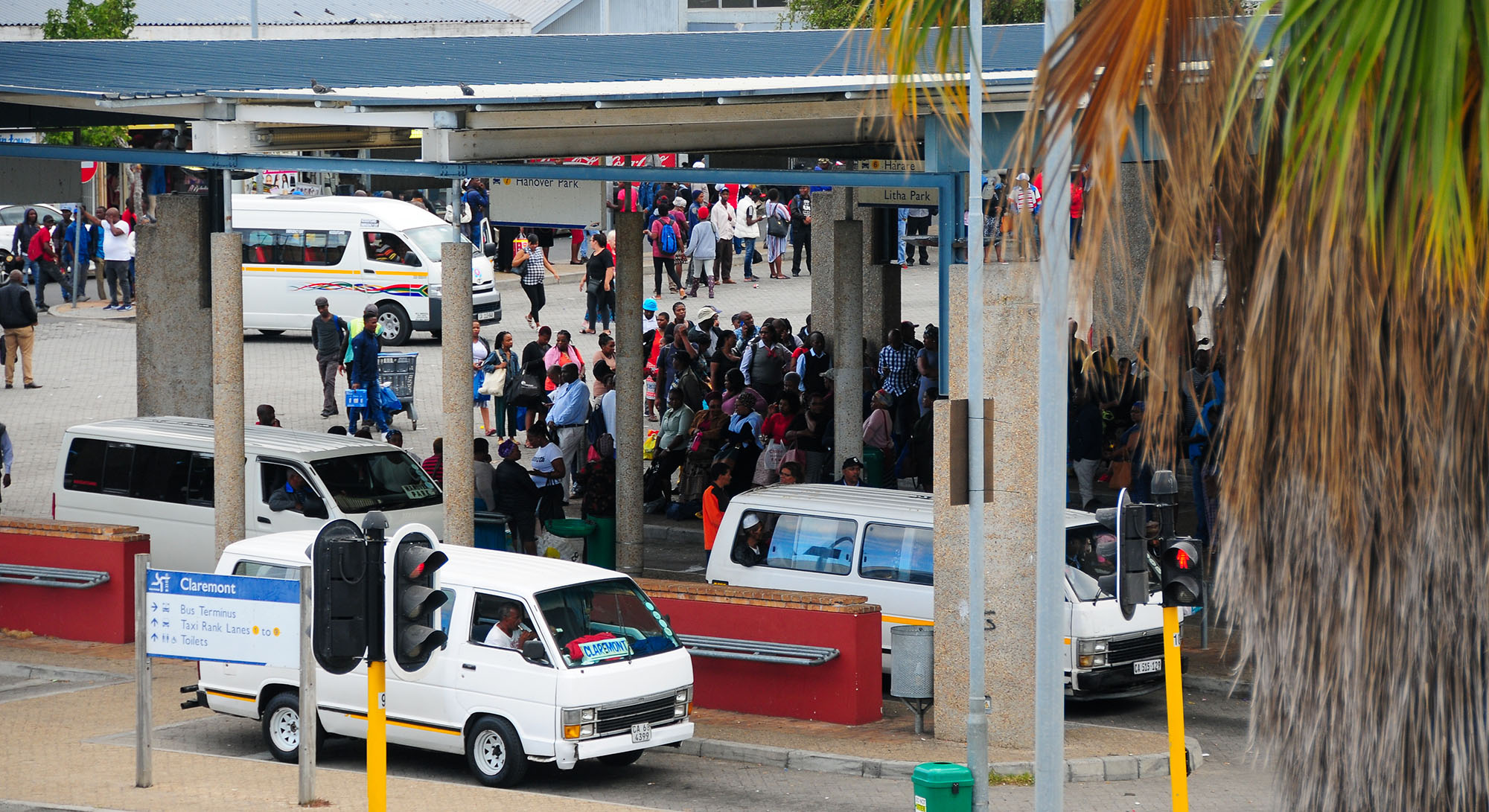
Claremont taxi rank during the afternoon peak, Cape Town. (Photo: Julia Evans)
If a taxi were charged off the grid, they found that an area filling half a tennis court’s worth of solar panels would be needed to meet the energy needs of a single taxi for a day.
Abraham’s programme used all the stopping point data to estimate the power of the charging stations needed to charge the vehicle, and figured out if a taxi used a 22kW charger (at the charging station), it would take four hours to charge, and last for a range of 130km.
They chose a slow charger (22kW) because a faster charger would have a bigger impact on the grid during peak times.
“Especially in South Africa, we’re going to have to implement very slow charging, otherwise, we are going to put too much strain on the grid,” Wüst said.
Fortunately, from the data they collected, they found that taxis actually have about two to four hours in the day where they actually stop and don’t drive passengers.
Wüst explained that for his research he surveyed taxis at a taxi rank in Stellenbosch, “and you could see, during midday, they were all just lining up – they formed a line that stretched for like at least 15 vehicles, standing in line doing nothing”, Wüst said. “I couldn’t believe it.”
So it is possible to find times for taxis to charge during the day, which considers their trip demands and puts less pressure on the grid, if the charging times are staggered and scheduled.
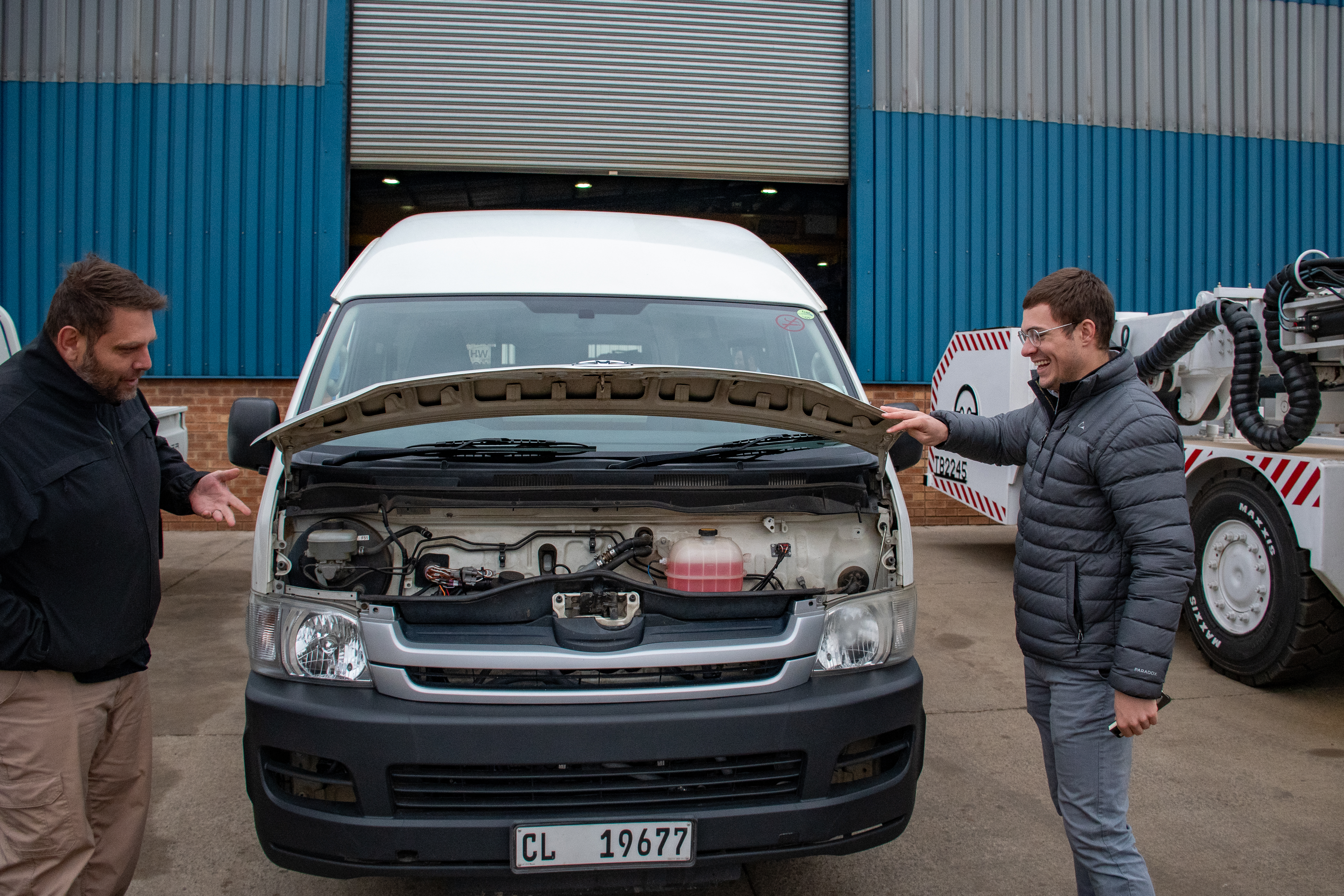
Donovan Kruger, the electronic development manager at Rham Equipment (left), with Stephan Lacock, master’s student in Electronic Engineering, whose research focuses on the designing and manufacturing of electric vehicles by retrofitting old internal combustion engine vehicles. Kruger and Lacock show where the previous engine used to be in the retrofitted taxi at Rham Equipment’s workshop, in Olifantsfontein, July 2023. (Photo: Julia Evans)
The faculty’s research found that to charge all the minibus taxis from the national grid would require just over 5%, or 33.7 gigawatt hours (GWh) of the current daily national energy generation.
A 2022 study co-authored by Booysen found that “to avoid further strain on the existing power grid, it would therefore make sense to charge the electric minibus taxis through a grid consisting of renewable energies”.
But these were all theoretical simulations – they had to test it for real.
Retrofitting an existing ICE taxi with an electric motor
“I’m trying to use the same simulations and actually build in the physical vehicle,” said Stephan Lacock, who is doing his master’s degree in electronic engineering with a focus on designing and manufacturing EVs by retrofitting old ICE vehicles.
Lacock said this initial taxi retrofit will be used to validate that the simulations are correct and to build the trust of local taxi owners and drivers.
Lacock was talking to Daily Maverick from Rham Equipment’s manufacturing workshop in Olifantsfontein, Johannesburg, the equipment-manufacturing entity Stellenbosch University has partnered with to build the EV taxi.
Rham specialises in producing mining equipment – but it has electrified about 10 mining vehicles, some of which have been retrofitted, so it is familiar with the process of retrofitting and electrifying vehicles.
“To manufacture these requires the type of skills that is rare in South Africa,” Lacock said, skills that the faculty initially struggled to find.
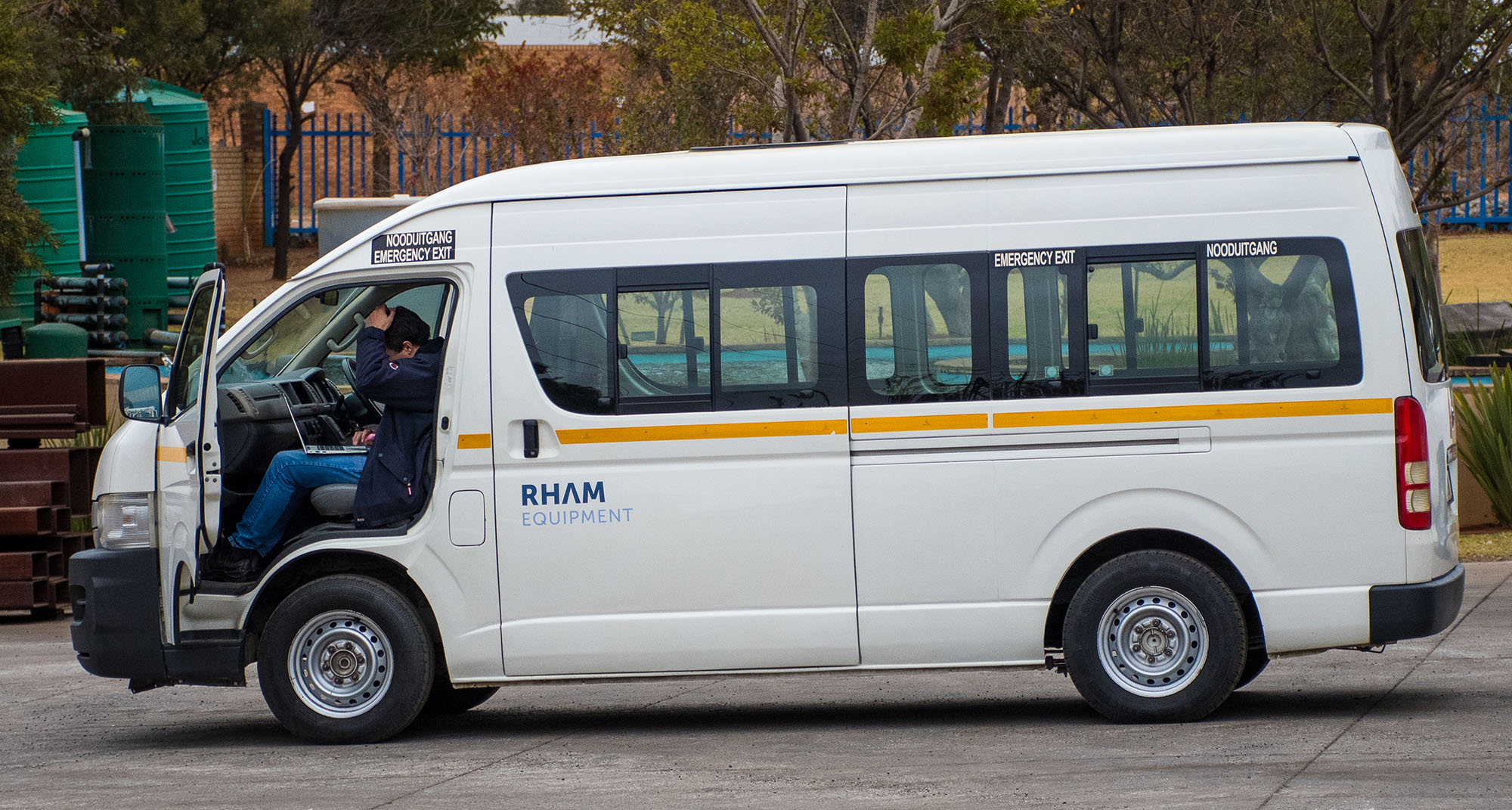
The taxi that was retrofitted with an electric motor and battery in a pilot project by Stellenbosch University and Rham Equipment, in Olifantsfontein, Gauteng. (Photo: Julia Evans)
Asked how they became involved in EVs as South Africa’s EV-manufacturing industry is non-existent, Donovan Kruger, Rham’s electronic development manager, said: “I know; we’re ahead of the game.” Going electric “is the future,” he added.
Instead of building an EV taxi from scratch, Stellenbosch decided to retrofit an existing ICE taxi with an electric motor and battery.
Lacock said the challenge was to stay within the road regulations – because there aren’t regulations for retrofitting right now, they had to stay within the same regulations of a normal ICE minibus taxi – meaning after the retrofit, the vehicle had to be the same weight, and they weren’t allowed to drill or cut into the chassis.
“So that’s the catch,” Lacock said. “The NRCS [National Regulator for Compulsory Specifications] are still in the process of figuring this out,” he said, adding that someone from the NRCS joined the project from the start and guided them as to what regulations they needed to follow.
A big critique of EVs is that they are heavier than ICE vehicles because the battery is so heavy. But the designers were able to make sure the retrofitted taxi was the same weight.
The original ICE and gearbox, which was 250kg, was replaced with a much lighter electric motor (30kg) and single-speed gearbox (20kg), allowing the engineers extra weight to accommodate the batteries.
This video shows the team at @RhamEquipment retrofitting an internal combustion engine (ICE) taxi with an electric motor (shown first), battery (in orange box), inverter and gearbox – making it SA’s first ever electric taxi. pic.twitter.com/KG8jVIE5vG
— Julia Evans (@Julia_J_Evans) August 13, 2023
Instead of a manual gearbox, the EV taxi has a single-speed gearbox and vehicle control unit that was 3D-printed at the workshop, which is more energy efficient.
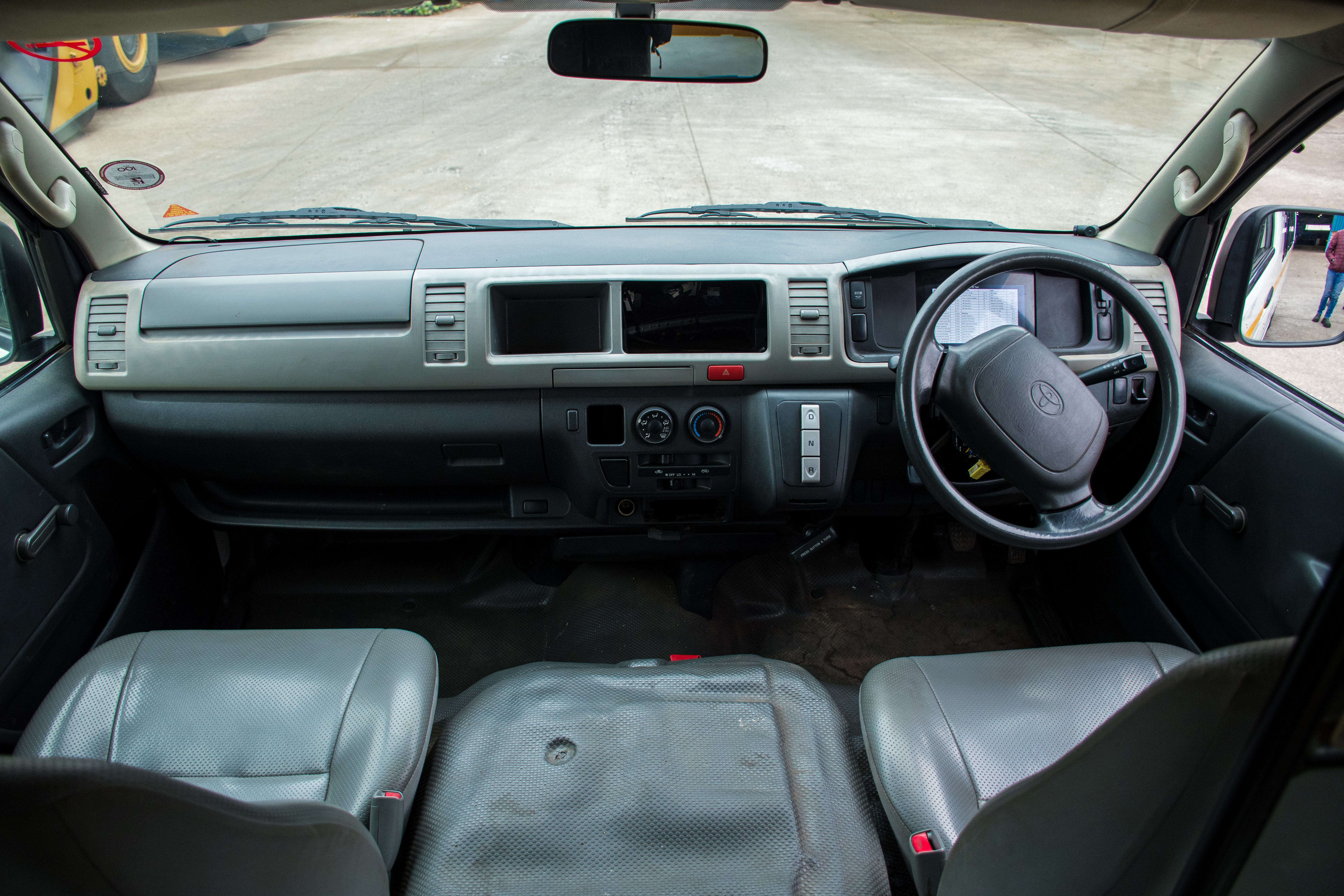
The vehicle control unit [D, N, R] was 3D-printed at the Rham Equipment workshop. (Photo: Julia Evans)
“There are many vehicles on the road that are completely roadworthy, and all you need to do is swap out the propulsion — the diesel engine or the petrol engine and the fuel and tank and gearbox — with an electric motor and regenerative braking, add a big battery and a battery management system,” Booysen said.
“And as soon as you’ve done that, you’ve got an electric vehicle that’s cheaper to run – and more energy efficient.”
Lacock explained that retrofitting is actually a lot cheaper than building an EV from scratch, because you only need to buy the electric motor, inverter and batteries – and it’s definitely cheaper than buying a brand new EV – because an EV would have to be imported.
“If a company retrofits an old vehicle, instead of writing that vehicle off and losing all that money, they’d save at least R500,000–R600,000 than if you bought a new one,” said Lacock.
Stellenbosch University is also doing a retrofit project with Golden Arrow Bus Services, which has 1,100 diesel buses that could be retrofitted.
Lacock said Golden Arrow needs to buy new buses every year to keep the fleet up to date, and is losing money by writing the old ones off.
Based on the Golden Arrow EV pilot programme, they calculated that they would save around R657,000 per bus per year if it was electric – saving on operational costs.
Lacock said retrofitting is the same principle as building a new EV; it’s just using the same frame and chassis, which is good because generally when an ICE reaches its end of life after 10 or 20 years, the frame of a vehicle is still functional.
“So now you can take that taxi and basically give it a second life by electrifying it,” said Pretorius.
And of course, retrofitting over building from scratch has a far smaller carbon footprint, because emissions will not be created in the manufacture of a new frame and chassis, and you’re using a vehicle that would have been dumped somewhere.
A stepping stone for the EV industry
The engineers explained that one reason they wanted to retrofit an existing vehicle rather than build from scratch is that they saw it as part of helping to develop EV skills in SA.
According to the National Association of Automobile Manufacturers of South Africa, almost 500,000 jobs are at risk if the country does not switch to electric and upskill the sector.
“There’s a lot of knowledge [of how to build EVs], but there’s not a lot of skills yet,” Lacock said. “That’s why this project is being done to try and develop those skills in South Africa.”
Lacock said that while SA definitely had the skill and the capability to build new EVs, “in order to make that mind shift, and that changes with the grid, retrofit is a great place to create that stepping stone in order for people in South Africa to start learning the skills and developing the skills and understanding the system, and hopefully from that take it further”.
Booysen said the next step would be developing the country’s own motors and vehicle controlling units. He added: “A big remaining challenge for SA is that we are not yet making batteries. For me, this is the big prize.”
Now that the EV taxi is up and running, it will be taken back to Stellenbosch – along with an EV built from scratch that was imported from China – to do an efficiency analysis and verify their simulations, to help determine where the charging stations need to be, where solar power is needed and what the load will be on the grid based on the efficiency.
“That’s the first thing because even though we do believe in electric mobility changeover, we know that the grid can’t handle it,” Lacock said.
“Yet we can’t stop, because somewhere in the future – in 2035 [when the EU and UK, our biggest exporters, have put a stop on ICEV sales] we need to be electric.” DM





















 Become an Insider
Become an Insider
Hahahahahahaha – Good one!!!
An exercise in futility. We do not have the electricity or the infrastructure for charging electric vehicles.
Amen to that. For more about how this nonsense is proceeding in the UK, EU and USA check out netzerowatch dot com.
Your attitude is a good example of why. Have you done anything to help develop such an infrastructure? We don’t have to do that from the grid – for the taxi’s, every taxi rank can create its own electricity plant by using the roof of the taxi rank for instance (and even expanding the roof to cover the whole stand in the process). The taxi owners are going to save so much money by moving to electric, that it is probably going to be worth it to make a common investment into such development. All that is needed is the willingness to take initiative, such as what these engineers are doing, instead of always shooting down those who are trying to make such positive difference. I am very impressed with this iniative; we can all learn from that. The next thing is of course to get a hydrogen infrastructure off the ground, especially for the purpose of powering ships, trains and long-distance heavy duty trucks (apparently Sasol & Toyota are already working on that); and once that is in place, a fuel cell car industry that ties in with that initiative because then the hydrogen fuel points will already be in place. But for short-distance city travel only by passengers, electric battery vehicles will probably be great. I am really looking forward to a clean SA.
Great! After this project, the next thing they can think of is to work out a manual for all of us on how to change our vehicles into either battery or fuel cell vehicles – just think on how much we shall each save on fuel costs once the infrastructure is in place!
I have been thinking for years of modifying my old boxy kombi (T3) into electric.
One single big electric motor slots in to the engine bay and onto the gearbox.
Leave the gearbox and have the speed control through the gearing.
The problem for me would be the taxi part. Too much risk with SANTACO.
I would do it for a bakkie (twin cab DOKA T3)
[email protected]
Eish we will call it de Ronson